|
2007 Peregrine Falcon Program Summary In 2007, 24 nestling peregrine falcons were released over the course of three separate hacks. This effort marked the largest release of peregrine falcons from a single site in the species' recovery history. A 100% success rate was observed using the 14-day criteria, which is phenomenal given the number of falcons that were released. In fact, only two falcons dispersed before being on the wing for 30 days (i.e. 27 and 29 days). Additionally, one falcon from the 2006 release was observed in NERI for nearly a week before dispersing out of the area. This year also marked the implementation of a solar powered video camera monitoring system, which was observable by not only NPS staff, but also the public from the Canyon Rim Visitor Center and from home via the internet. The camera system allowed NPS staff and the public to observe the falcon's development and behavior prior to and following the falcon's release. 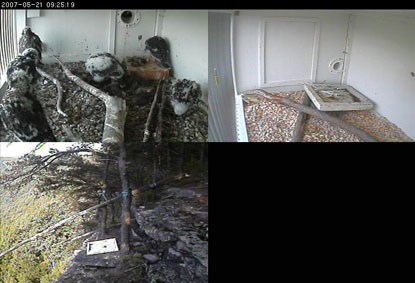
A month after the release of the third group of falcons from the hack site, NPS staff were offered a unique opportunity to track six falcons using satellite technology. On July 18, the park obtained six satellite transmitters from the College of William and Mary and VA Dept of Game and Inland Fisheries. These transmitters, valued at $18,000.00, were donated to the park for attachment and subsequent tracking of the newly released peregrine falcons at NERI. The transmitter is a solar powered unit that charges a battery which fuels a capacitor and the operating software within the unit. The transmitters will last at least 3 years, providing daily location data that is collected from 1300-2000 hours. The data collected are not continuous, but provide single point-in-time locations of individual birds daily. 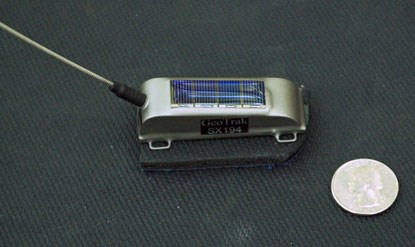
Following the approval of park management, resource management staff designed a method of trapping the falcons, which was based upon the Indian bal-chatri or “boy’s umbrella” trap. The ancient trap used horsehair nooses and cane baskets containing live prey, which enticed raptors to land on the noose covered basket, thus leading to their capture. The trap that NERI staff developed was based on the white plywood feeding trays that had been used to provide quail to the falcons following release. (Note: Juvenile falcons cannot hunt on their own for 3-5 weeks after they take flight) The modified feeding trays were covered with 20lb monofilament nooses, utilizing a special locking slipknot to insure capture, once a bird was entangled. Following capture, the falcons were quickly restrained and removed from the trap, with special attention being placed on the removal of the monofilament from the bird’s legs.
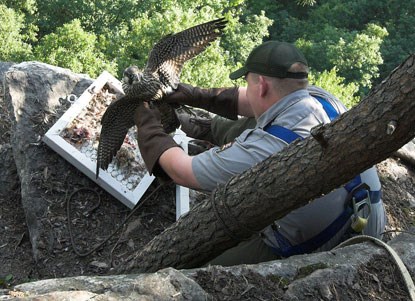
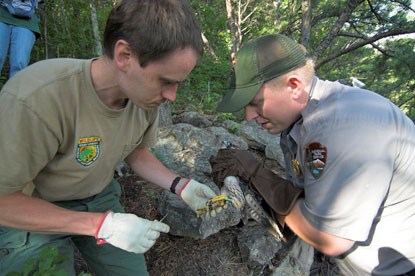
On July 20-21, NPS and WVDNR staff assisted by numerous volunteers initiated the recapture operation on the cliff. All of the falcons had been on the wing for at least 32 days, so we felt that the odds of capturing six falcons would be low. However, by the end of the day on the 19th, the team had successfully captured 5 falcons. On the 20th, the team worked the trap the entire day and just before dark, the last falcon was captured. During the trapping operation on the 20th, the five previously captured falcons were fitted with the satellite transmitters and released by staff from the NPS, WVDNR, Three Rivers Avian Center, and the College of William and Mary. The process of attaching the transmitter takes 30-60 minutes for each falcon, due to the precise fit required when attaching such a device to wild animal. Although falcons can survive for over 15 years, the reality is that 90% of juvenile falcons perish before reaching sexual maturity at age 3.
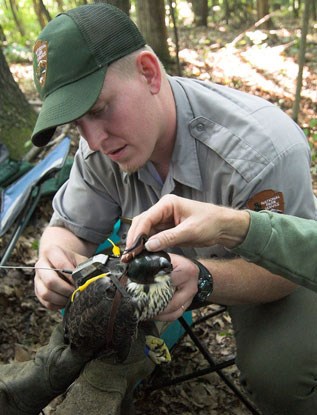
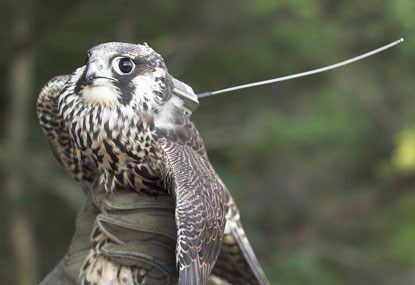
Since the 21st, the six peregrine falcons fitted with transmitters have ventured into 12 states and Canada. The wandering activity of the falcons is typical for juvenile raptors, especially peregrine falcons. Consequently, this wandering behavior oftentimes results in the falcons roosting in unknown territory that presents unknown risks. Statistically, all but 2-3 of the released falcons from 2007 will perish before their 3rd birthday; however we are hopeful that the NERI falcons can beat the odds at becoming breeding adults in the future. 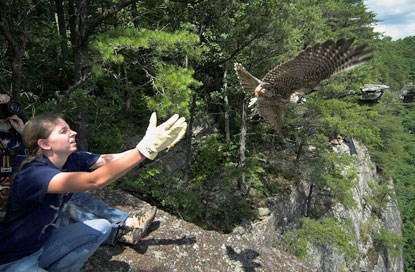
Take a look at the information on the falcons being monitored using satellite tracking. We have also added short biographies for each of the birds.
- Updated 7 February 2008 | ||
Last updated: November 14, 2017
